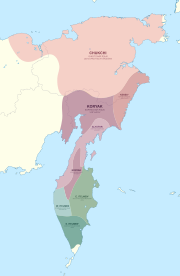Kerek language
- View a machine-translated version of the Russian article.
- Machine translation, like DeepL or Google Translate, is a useful starting point for translations, but translators must revise errors as necessary and confirm that the translation is accurate, rather than simply copy-pasting machine-translated text into the English Wikipedia.
- Consider adding a topic to this template: there are already 1,239 articles in the main category, and specifying
|topic=will aid in categorization. - Do not translate text that appears unreliable or low-quality. If possible, verify the text with references provided in the foreign-language article.
- You must provide copyright attribution in the edit summary accompanying your translation by providing an interlanguage link to the source of your translation. A model attribution edit summary is
Content in this edit is translated from the existing Russian Wikipedia article at [[:ru:Керекский язык]]; see its history for attribution. - You may also add the template
{{Translated|ru|Керекский язык}}to the talk page. - For more guidance, see Wikipedia:Translation.
| Kerek | |
|---|---|
| Native to | Russia |
| Region | Chukotka Autonomous Okrug |
| Ethnicity | Kereks |
| Extinct | 2005[1] |
Language family | Chukotko-Kamchatkan
|
| Dialects |
|
| Language codes | |
| ISO 639-3 | krk |
Linguist List | krk.html |
| Glottolog | kere1280 |
| ELP | Kerek |
 Pre-contact distribution of Kerek (dark orange) and other Chukotko-Kamchatkan languages | |
Kerek (Russian: Керекский язык, romanized: Kereksky yazyk) is an extinct language in Russia of the northern branch of the Chukotko-Kamchatkan languages. On historical linguistic grounds it is most closely related to Koryak (both languages have a merger of the Proto-Chukotko-Kamchatkan phonemes /*ð/ and /*r/ with /*j/). The next closest relative is Chukchi (/*ð/ and /*r/ are merged, but not /*j/).
In 1997 there were still two speakers remaining, but by 2005 the language was considered extinct.[2] According to the 2010 census,[3] there were 10 people claiming Kerek as their native language, believed to only consist of partial speakers and non-speakers who claim the language as part of their ethnic heritage. Over the 20th century many members of the Kerek ethnic group shifted to Chukchi, the language of the majority ethnic group in the area, but now most Chukchis and Kereks speak Russian.
Phonology
Vowels
| Front | Central | Back | |
|---|---|---|---|
| Close | [i] | [u] | |
| Mid | [ə] | [o] | |
| Open | [a] |
Vowels may be long.
Consonants
| Bilabial | Dental | Palatal | Velar | Uvular | Pharyngeal | Glottal | |
|---|---|---|---|---|---|---|---|
| Plosive | [p] | [t] | [k] | [q] | [ʔ] | ||
| Fricative | [ħ] | ||||||
| Affricate | [tʃ] | ||||||
| Nasal | [m] | [n] | [ŋ] | ||||
| Lateral | [l] | ||||||
| Semivowel | [w] | [j] |
Consonants may also be long, [l] is palatalized intervocalically, and [tʃ] is pronounced as [s] by some.
Dialects
There were two dialects, the Maino-Pilgin and Khatyr dialects.[4]
Grammar
Kerek is an agglutinative language, meaning that the morphemes build on each other to have different meanings.[5]
References
- ^ Kerek at Ethnologue (18th ed., 2015) (subscription required)
- ^ Fortescue, Michael 2005. Comparative Chukotko-Kamchatkan Dictionary. Berlin / New York: Mouton de Gruyter.
- ^ 2010 census
- ^ "КЕРЕКСКИЙ ЯЗЫК • Большая российская энциклопедия - электронная версия". old.bigenc.ru. Retrieved 20 April 2024.
- ^ "Endangered Languages of Siberia – The Kerek Language". lingsib.iea.ras.ru. Retrieved 10 February 2017.
External links
- Bibliography
- v
- t
- e
| Chukotkan | |
|---|---|
| Kamchatkan |

| Northern | |
|---|---|
| Southern |











